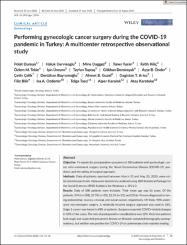| dc.contributor.author | Dursun, Polat | |
| dc.contributor.author | Dervişoğlu, Haluk | |
| dc.contributor.author | Dağgez, Mine | |
| dc.contributor.author | Turan, Taner | |
| dc.contributor.author | Kılıç, Fatih | |
| dc.contributor.author | Tekin, Özlem M. | |
| dc.contributor.author | Üreyen, Işın | |
| dc.contributor.author | Toptaş, Tayfun | |
| dc.contributor.author | Demirayak, Gökhan | |
| dc.contributor.author | Önder, Ayşe B. | |
| dc.contributor.author | Çelik, Çetin | |
| dc.contributor.author | Bayramoğlu, Denizhan | |
| dc.contributor.author | Güzel, Ahmet B. | |
| dc.contributor.author | Arıöz, Dağıstan Tolga | |
| dc.contributor.author | Bilir, Filiz | |
| dc.contributor.author | Özdemir, İsa A. | |
| dc.contributor.author | Taşçı, Tolga | |
| dc.contributor.author | Karalök, Alper | |
| dc.contributor.author | Karateke, Ateş | |
| dc.date.accessioned | 2021-05-05T22:14:07Z | |
| dc.date.available | 2021-05-05T22:14:07Z | |
| dc.date.issued | 2020 | |
| dc.identifier.issn | 0020-7292 | |
| dc.identifier.issn | 1879-3479 | |
| dc.identifier.uri | https://doi.org/10.1002/ijgo.13296 | |
| dc.identifier.uri | https://hdl.handle.net/20.500.12933/308 | |
| dc.description | WOS:000558055200001 | en_US |
| dc.description | PubMed: 32623717 | en_US |
| dc.description.abstract | Objective To report the perioperative outcomes of 200 patients with gynecologic cancer who underwent surgery during the Novel Coronavirus Disease (COVID-19) pandemic and the safety of surgical approach. Methods Data of patients operated between March 10 and May 20, 2020, were collected retrospectively. Data were statistically analyzed using IBM Statistical Package for the Social Sciences (SPSS) Statistics for Windows v. SP21.0. Results Data of 200 patients were included. Their mean age was 56 years. Of the patients, 54% (n=108), 27.5% (n=55), 12.5% (n=25), and 2% (n=4) were diagnosed as having endometrial, ovarian, cervical, and vulvar cancer, respectively. Of them, 98% underwent non-emergent surgery. A minimally invasive surgical approach was used in 18%. Stage 1 cancer was found in 68% of patients. Surgeons reported COVID-related changes in 10% of the cases. The rate of postoperative complications was 12%. Only two patients had cough and suspected pneumonic lesions on thoracic computed tomography postoperatively, but neither was positive for COVID-19 on polymerase chain reaction testing. Conclusion Based on the present findings, it is thought that gynecologic cancer surgery should continue during the COVID-19 pandemic while adhering to the measures. Postponement or non-surgical management should only be considered in patients with documented infection. Gynecologic cancer surgery should continue during the COVID-19 pandemic while adhering to measures. Only 1% of patients developed COVID-19-related symptoms during the postoperative follow-up period. | en_US |
| dc.language.iso | eng | en_US |
| dc.publisher | Wiley | en_US |
| dc.rights | info:eu-repo/semantics/openAccess | en_US |
| dc.subject | COVID-19 | en_US |
| dc.subject | Gynecologic surgical procedures | en_US |
| dc.subject | Lymph node excision | en_US |
| dc.subject | Ovarian neoplasms | en_US |
| dc.subject | Severe acute respiratory syndrome coronavirus 2 | en_US |
| dc.subject | Uterine cervical neoplasms | en_US |
| dc.subject | Uterine neoplasms | en_US |
| dc.subject | Vulvar neoplasms | en_US |
| dc.title | Performing gynecologic cancer surgery during the COVID-19 pandemic in Turkey: A multicenter retrospective observational study | en_US |
| dc.type | article | en_US |
| dc.department | AFSÜ, Tıp Fakültesi, Cerrahi Tıp Bilimleri Bölümü, Kadın Hastalıkları ve Doğum Ana Bilim Dalı | en_US |
| dc.contributor.institutionauthor | Arıöz, Dağıstan Tolga | |
| dc.contributor.institutionauthor | Bilir, Filiz | |
| dc.identifier.doi | 10.1002/ijgo.13296 | |
| dc.identifier.volume | 151 | en_US |
| dc.identifier.issue | 1 | en_US |
| dc.identifier.startpage | 33 | en_US |
| dc.identifier.endpage | 38 | en_US |
| dc.relation.journal | International Journal Of Gynecology & Obstetrics | en_US |
| dc.relation.publicationcategory | Makale - Uluslararası Hakemli Dergi - Kurum Öğretim Elemanı | en_US |
















